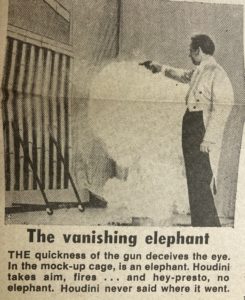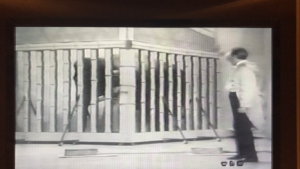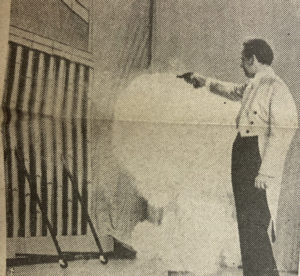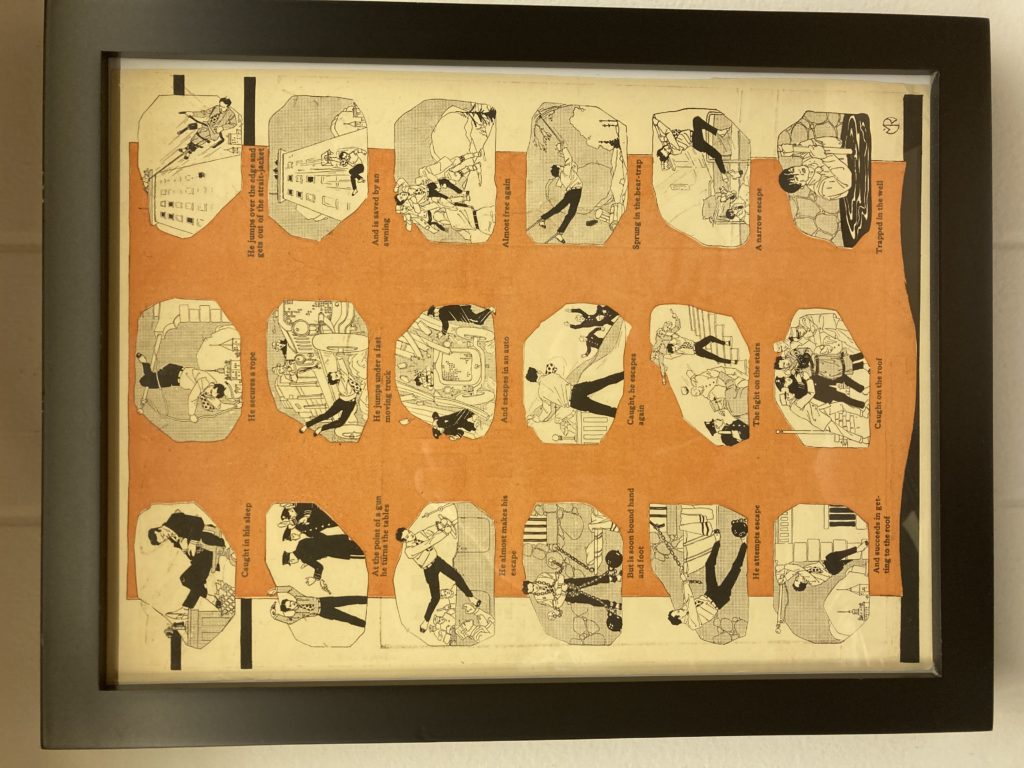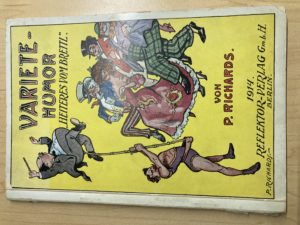
HHCE Collection
I recently acquired a very scarce German book (90 pages) by P Richards that had a splendid sketch on Houdini in it.

HHCE Collection
This led me to try and find out more about P. Richards and his connection to Houdini.
According to THE NEW YORK CLIPPER
P. RICHARDS, LIGHTNING CARICATURIST 6 February 1892
Recognized by leading papers and responsible managers as Strongest Comical Specialty. A1 Advertising Artist (late of NEW YORK HERALD, CHICAGO DAILY NEWS and LONDON ARGUS). Minstrels, Combination Companies of Circus, wishing to arrange for season at moderate terms. Address GENERAL DELIVERY, Chicago , Ill
P RICHARDS LEFT EUROPE SEPT 8, 1902 for AMERICA [Chicago]
He traveled for the past Summer in Europe, in the interest of Richard Pitrot, manager of European novelties for this country, visiting Germany, France, Russia, Italy, Holland and Austria, and has contracted for many attractions for America, and also booked many American acts in Europe.
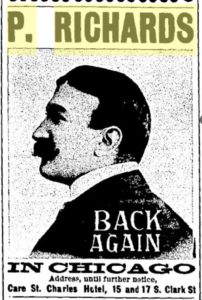
Starting in 1903, P. Richards profusely illustrated his “Vaudeville Favorites” magazine devoted exclusively to Vaudeville, which led to a book in 1905, The Vaudeville Review of Vaudeville Favorites:

Ad from Stanyon’s Magic Magazine May 1905
In May 1905, THE CLIPPER announced that Mr. P. Richards would be one of THE CLIPPER Staff and produce each week a full page cartoon, illustrating in a humorous way, the leading features of theatrical and vaudeville productions.
In 1906, THE CLIPPER added a new publication entitled CLIPPER CARTOONS, that contained original drawings by the celebrated artist P. Richards.
THE NEW YORK CLIPPER announced that P. Richards, THE CLIPPER’s artist started his European tour on June 8, 1907. The artist continued his popular “Patsy Bolivar” series from abroad, sending to THE CLIPPER his impressions of every large city he visited, in the form of a full-page cartoon.
P Richards left Europe Sept 7, 1907 for America [New York] to resume for THE CLIPPER his original idea of cartooning the principal features of the leading dramatic and vaudeville productions.
In 1907, Harry Houdini’s Conjurer’s Monthly Magazine for July and August mentioned P. Richards sketches of magicians and men of mystery:
P Richards, the well-known cartoonist of the New York Clipper has gone abroad and is sending home every week a full page cartoon of “Patsy-Boliver.” Richards has drawn more magicians and men of mystery in his sketches than any other artist that we have heard of.
In 1908, THE CLIPPER Cartoonist, left for Europe again:
The growing interest of foreign performers in THE NEW YORK CLIPPER, together with the difficulties which the American performers appearing in Europe for the first time have to overcome, have induced the publishers of THE CLIPPER to establish a branch office in Berlin, Germany. This office will be known as the Berlin Bureau of THE NEW YORK CLIPPER, and will be under the direction of Mr. P. Richards, our widely known and popular cartoonist.
Having been born in Vienna, and thoroughly versed in the language and customs of the country, together with an extensive personal acquaintance with most of the foreign performers, Mr. Richards is eminently fitted for the position of manager of our Bureau. It will be his pleasure to give all the assistance in his power, both to foreign acts coming to America and in American acts visiting Berlin. He will also render valuable aid in receiving and forwarding the mail of performers traveling in Europe, and being familiar with the show business is both countries, he can give valuable advice to foreign performers contemplating coming to America, as well as important information to those American artists visiting Berlin. It is expected that this Berlin Bureau will be a great convenience to the performance of both continents. Mr. Richards will sail for Europe on July 25, 1908 and immediately upon his arrival will establish the Bureau, the location of which we will announce later.
P RICHARDS LETTER New York Clipper, 3 October 1908:
Circus Busch opened on Sept. 10, 1908 with Houdini as the feature, and the kind reception which was given to this performer proved the good memory of the audience, since he has not appeared in Berlin for the last five years. Houdini introduced, besides his famous escape from the straitjacket, an entire novelty in the form of his original can trick, where he allows himself to be handcuffed and then to be locked into a big can filled up the brim with water, from which he comes forth after a couple of minutes unharmed and—minus handcuffs. As he has a standing offer for 1,000 marks to anyone proving any portion of his exhibition a “fake”, the committee in the ring tries its utmost to earn the tempting prize, and submits Houdini, tin can and even the sawdust, around them, to a most thorough examination, without success (so far). Frobel and Ruge, besides Houdini are the only Americans on the bill.
P RICHARDS’ FAREWELL LETTER New York Clipper, 6 January 1912
This being my last letter in these columns (my contract with THE CLIPPER expiring on Jan. 1, 1912, and my time of being too much occupied with my illustrative work to permit me a continuance of thanking THE OLD RELIABLE, its highly esteemed managing editor, and also my friendly co-workers on THE CLIPPER staff, for all the kindness and congeniality bestowed upon me during the nearly seven years of our pleasant relations, and conclude herewith by wishing them, one and all, A HAPPY AND PROSPEROUS NEW YEAR.
P RICHARDS’ BOOK New York Clipper, 22 February 1912
“Zeichner and Gezeichnete,” “Sketcher and Sketched,” the new publication by P. Richards, the well-known artist and cartoonist, has reached THE CLIPPER. It is richly illustrated with original sketches, some of which had been drawn for THE CLIPPER, and cuts made from photos collected by Mr. Richards during his extensive travels. Interesting descriptions of incidents and places have found their way into this volume in German text, and it should find a ready sale among all classes of readers.
SHOULD AULD ACQUAINTANCE BE FORGOT New York Clipper, 31 May 1913
When P. Richards, the artist-author of International fame, some time ago reluctantly discontinued his Berlin Letters , which had been a most entertaining feature of THE NEW YORK CLIPPER for the past few years , he informed us that he was going to devote ln future all of his time and best efforts to the issue of a series of books, for which task he had been engaged by one of the most prominent publishers ( The Reflecklor-Verlag , Berlin-Leipzig ), of Germany. How conscientiously he must have been at work ever since ls amply proven by the first two volumes of his publications, which have been Issued recently and have just reached our office: “Zeichner Gezciehnete (“Caricaturists and Their Victims”) is a handsomely printed and bound volume , in which all of Richards wealth of distinguished acquaintances (especially in the theatrical and vaudeville field) have been utilized . A man possessing such a wide and rich experience has a right to glory in the memories upon which he can draw for his own pleasure and for the public’s benefit. The book contains a great number of photographs and also many sketches by the prolific pen of the author (two hundred and sixty-five illustrations in all), and ought to prove highly interesting and amusing , even to those who are not able to follow the German text. “Amerika Durch die Lupe der Karikatur” (America as Seen by a Caricaturist) . A beautiful album of large dimensions, most handsomely bound and printed . This is a picture work in the first place , being decorated throughout with full-page drawings , although there Is enough descriptive text to it to make it interesting reading as well. All phases of American life ore subjected to good-natured caricatures of sparkling, effervescent humor, quite in harmony with the vivacious tone of the work. Both of these volumes are enjoying a most enthusiastic reception by the public and the press of the Continent, and Richards may well be congratulated upon renewing his American success as an artist-author, also on German soil . Zeichner and Gezciehnete” sent post-free on receipt of $1.25, and “Amerika durch die Lupe der Karikatur” sent post-free on receipt of $ 1.75 , by Reflecklor Verlag, Querstrasse 26, Leipzig ( Germany ).
In 1914 he published this book, Varieté-Humor – Heiteres vom Brettl, Berlin (Reflektor), with sketchen on celebrated performers of the Music Hall (Variety Theatre) World. I am very lucky to have this extremely rare book in my collection. Unlike P. Richards other books, this is the only copy I have ever seen; and its the only one with a sketch of Houdini.

